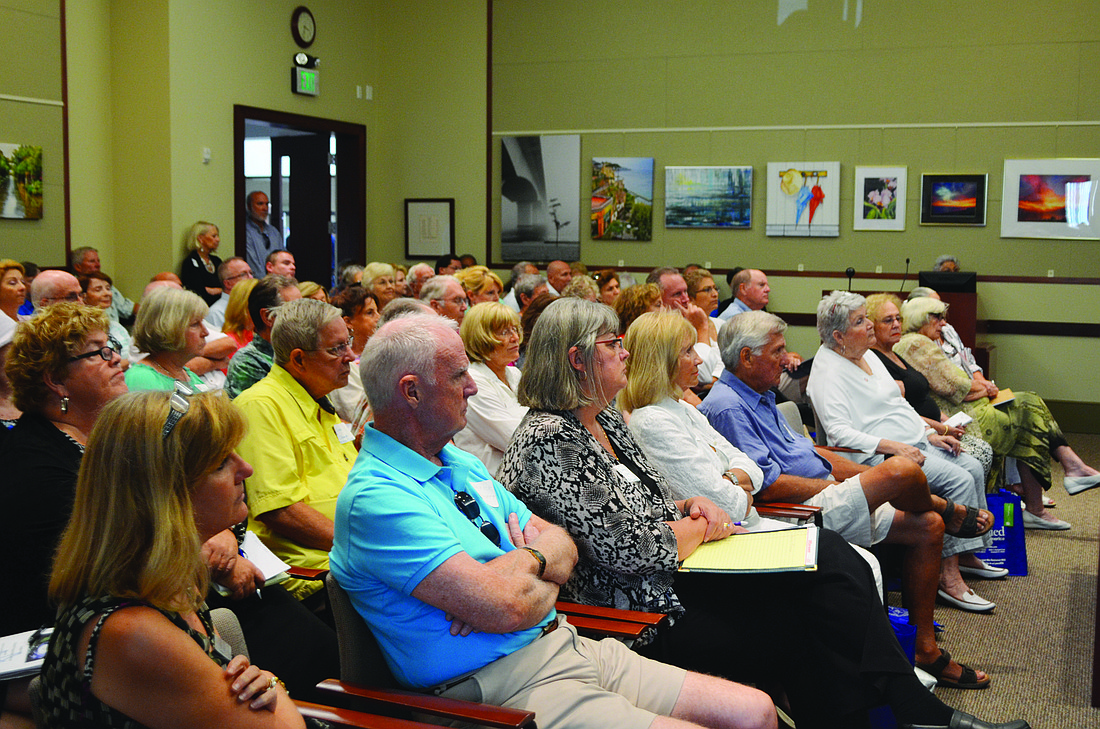- November 28, 2024
-
-
Loading

Loading

“It only takes once.”
The message is so paramount to hurricane preparation that Sarasota County Emergency Management Chief Ed McCrane asked the audience to repeat it with him at the Longboat Key Disaster Preparedness Seminar.
The last time Longboat Key and the greater Sarasota area had a direct hit from a hurricane was 1944. But at the June 19 seminar, an audience filled commission chambers and the adjacent conference room to capacity as officials spoke about what will happen before, during and after a storm — in case Longboat Key isn’t so lucky this season.
Bryan Koon, director of the Florida Division of Emergency Management, was the keynote speaker at the event. Other speakers included McCrane, Manatee County Emergency Management Chief Don Hermey, Longboat Key Fire Rescue Chief Paul Dezzi, Longboat Key Police Chief Pete Cumming and Longboat Key Public Works Director Juan Florensa.
Koon told residents they might receive orders to evacuate three or four days before a storm makes landfall. He urged the audience to heed officials’ warnings.
“If you wait, you’re gonna get stuck on the mainland behind everyone else who’s going somewhere else,” he said.
Koon explained the difference between a state of emergency and a disaster declaration: A state of emergency, which a governor can declare, merely expedites various governmental processes but does not include extra money.
A federally declared disaster area brings in both individual and public assistance for rebuilding from the Federal Emergency Management Agency (FEMA) and other agencies.
Koon told the audience that some forecasting measures are constantly improving. The cone, which predicts where a storm will go, keeps getting smaller, meaning its accuracy is getting better. However, prediction models about whether a storm will strengthen or diminish have not improved significantly.
Typically, officials prepare for a storm that’s one level higher than forecasts predict, out of precaution.
“The fact is, we know that the forecast for intensity is not where we would like it to be one day,” Koon said.
Hermey urged residents to pay attention to local media instead of national outlets for up-to-date storm information.
“The focus of CNN or the Weather Channel is different,” Hermey said. “(Local media are) going to have the best insight on what we’re doing, when we’re doing it and why we’re doing it.”
Preparation checklist
If possible, make plans to stay with friends/relatives or at a hotel instead of a government shelter.
Provide your contact info to the town to receive CodeRED Emergency Notifications. Visit the town’s website, longboatkey.org, and click on “CodeRED” under the “residents” tab.
Prepare a seven-day emergency kit for each individual and pet in the household, including at least one gallon of water per person per day, nonperishable food, medications, first-aid supplies, tools and clothing and bedding stored in waterproof containers.
Place important documents and important phone numbers in a waterproof, lockable container that you can easily grab if you have to evacuate.
Make arrangements for pets with a clinic or kennel well in advance; available spaces fill up quickly as a storm approaches, and public shelters do not accept pets.
People with special needs who require assistance during an evacuation should register in the county in which they reside. Contact Longboat Key Fire Rescue at 316-1945.
Longboat Key's hurricane history
Hurricane of 1848 — A storm separated present-day Longboat Key from Lido Pass, creating what Sarasota settler William “Bill” Whitaker called a “new pass.” The New Pass name stuck with the new body of water. (Hurricanes were not named until 1950.)
Hurricane of 1921 — An October 1921 hurricane wiped out early farming activity on the Key.
Hurricane of 1944 — The last major hurricane to directly strike the Sarasota-Manatee area made landfall in Englewood.
Hurricane Agnes, 1972 — The hurricane destroyed at least 25 homes and caused major damage to at least a half-dozen motels on Longboat Key and Anna Maria.
Hurricane Elena, 1985 — The Labor Day storm struck to the north of the Key but brought estimated damages of $5 million, in part because winds hit their highest speeds at extremely high tide.
Hurricane season 2004 — Hurricanes Charley, Frances, Ivan and Jeanne threatened the Key but spared it of major damage.
Hurricane season 2005 — Hurricane Dennis brought floods to the Longbeach Village, and Hurricane Wilma brought minor damages but the Key avoided major storms of the season, such as hurricanes Katrina and Rita.
Tropical Storm Debby, 2012 — Longboat Key’s last brush with a tropical storm or hurricane brought flooding, high winds and beach erosion.
Re-entry plan
Residents and Key employees should bring photo identification, such as a driver’s license or employment photo identification, and proof of Longboat Key residency, such as a phone or electric bill, rental agreement or copy of their homeowner insurance policy with them when they evacuate.
Re-entry will occur in a tiered system.
Tier I: Town employees and other authorized federal, state and local agencies that need immediate access to the area to restore critical services will be the first group allowed to return to the island.
Tier II: The second group that will be permitted to return consists of public- and private-sector individuals who support the re-establishment of critical infrastructure. This tier includes relief workers, health care agencies, insurance agents, banking organizations, suppliers of food and condominium and hotel leaders and staff.
Tier III: Town residents and businesses that are not included in Tier III will return to the island.
During the Tier II and III identification process, agents will confirm residency or business affiliation and assign a decal to authorized vehicles.
Name dropping
2014 Atlantic tropical and subtropical storm names
Arthur
Bertha
Cristobal
Dolly
Edouard
Fay
Gonzalo
Hanna
Isaias
Josephine
Kyle
Laura
Marco
Nana
Omar
Paulette
Rene
Sally
Teddy
Vicky
Wilfred
Contact Robin Hartill at [email protected]